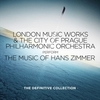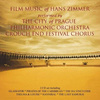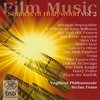Soundtrack Information

The Last Samurai
Elektra (62932-2)
Release Date: November 25, 2003
Conducted by Blake Neely
Performed by
The Hollywood Studio Symphony
Formats: CD, Digital
Music From
Music By
Purchase Soundtrack
Track Listing
Related Albums

The Music of Hans Zimmer: The Definitive CollectionSilva (SILCD1453)
Released: July 28, 2014
Formats: CD, Digital (361 min)

Film Music of Hans ZimmerSilva Screen Records, Ltd. (SILCD 1238)
Released: June 12, 2007
Format: CD (107 min)
Music Used in Trailers
 Theatrical Trailer
Theatrical Trailer- Memoirs of a Geisha (2005) - Hans Zimmer
- "Ronin" Spider-Man 2 (2004) - Hans Zimmer
- "Spectres in the Fog" The Painted Veil (2006) - Hans Zimmer
- The Village (2004) - Hans Zimmer
Trailer #2  Teaser Trailer
Teaser Trailer- Memoirs of a Geisha (2005) - Hans Zimmer
 TV Spots
TV Spots- "Ronin" The Forgotten (2004) - Hans Zimmer
- "Ronin" The Village (2004) - Hans Zimmer
 International Trailer
International Trailer- War of the Worlds (2005) - Hans Zimmer
Review: The Last Samurai
4.5 / 5 Stars
Unlike the beginnings of many Hans Zimmer scores (Gladiator, Spirit: Stallion of the Cimarron, Pearl Harbor) The Last Samurai score does not open with a powerful main theme performed by the French horns. Rather, the first track, "A Way of Life", starts almost inaudibly with gentle ethnic instrumentation on flute and strings. Halfway through the track—the longest on the album—we hear a set of chord progressions similar to the renowned "Journey to the Line" from Zimmer's Thin Red Line, but here it is only played on the strings and sets a very different tone. Toward the end of the track, lower strings and bass come in with a darker tone and the theme for Tom Cruise's American character, Nathan Algren, makes its first appearance. It is used here in a slow, dramatic variation before being played in full, backed by the Japanese flute (fue), reminiscent of Zimmer's Beyond Rangoon.
The second track, "Spectres in the Fog", introduces the theme for the Samurai on strings backed by koto and rumbling Taiko beats. At the end of the cue, the low brass comes in with a Gladiator-esque action rhythm before the American theme is played out again, this time in a much faster and more dramatic statement. There is a koto motif played behind the Samurai theme in certain variations, most notably tracks 2 and 7, which is also used alone. The next two tracks build the Samurai theme and the Taiko and koto instrumentation. The theme is played out in full at the end of "Taken." "A Hard Teacher" is very Thin Red Line-ish with a more Asian instrumentation.
"To Know My Enemy" is a transitional track and one of the highlights of the album. After an extensive and very impressive Taiko performance is the Samurai theme, interspersed with bits of the American theme until the latter is finally played out slowly in full. It really captures the essence of Algren's character beginning to understand the Samurai ways. The mix of the themes is done intricately and subtly. The opening chords of both the Samurai and the American themes—depending on the variation—are similar and often one theme will slip into the other unexpectedly.
The single most stunning cue on the album comes in the final two minutes of "Idyll's End." After a variation of the Samurai theme in the strings backed by light percussion, the brass comes in with a new variation on the Samurai theme, which is as awe inspiring as the brass themes from Gladiator's "Barbarian Horde." It is a brass rendition of the koto backbeat to the Samurai theme, passed between different brass tones numerous times. However, this is also a variation of the Samurai theme itself. The track closes with Zimmer's trademark chimes, four notes in line with the Samurai theme, then crescendos into the next track.
The second half of the album is more action-oriented. "Safe Passage" brings out the American theme again, which is not used as much as I had expected, but is very prominent when it is. "Ronin" is a short track that displays the full capacity of the Taiko drums in action film music. "Red Warrior" continues this, with the first action scene opening with the cries of a male choir. It is an odd effect and one I've never heard in film music before, like war cries, but it actually is very much like the vocals that can accompany certain Taiko performances (kiai—meaning "energy-meeting" for focused vocalizations), only with a war cry twist. The track speeds to a close with a fiddle in the background and picks up the tempo like the end of Tears of the Sun until it feels nearly out of control and then gives way to a full rendition of the American theme.
"The Way of the Sword" covers the last battle sequence and it is unlike any other action piece Zimmer has done. Taiko's pound out rhythms in the background while the strings take most of the thematic material, giving way to toned-down brass only a few times. The final variations of the themes are played out here: it is the American theme, nearly unrecognizable in its resemblance to the Samurai theme, which it starts as, then shifts to Algren's theme. The latter part of this track and the final one, "A Small Measure of Peace," close the album quietly, segueing back to Thin Red Line-esque layered string textures. Snippets of the themes are present here, but very subtle. The Taiko and brass make a final appearance, taking over briefly for the strings, but the music shifts back to the strings quickly. The track closes with a return to the "Journey to the Line"-like chord progressions from the first track.
Thematically, Gladiator was more expansive. However, The Last Samurai is deeper because of the way Zimmer fused the ethnic instruments into it, something he could not do to the same extent with Gladiator. Additionally, The Last Samurai is more cohesive. The themes and instruments segue together in very fluid transitions. The Last Samurai is one of Zimmer's most solid efforts since Thin Red Line and Gladiator. It takes the Asian instrumentation to a level above even Jerry Goldsmith's Mulan. There is no other composer better suited for this score. Zimmer redefined modern film music and here he takes his standard American themes and molds them into Japanese instrumentation the same way Algren is taken into the Japanese culture.The most impressive aspect if this score is its authenticity. Most notable are the use of Taiko drums. These instruments were used on the battlefield to send out orders and only recently (mid-1900's or so) have developed into a solo instrument used for performance. Many modern scores utilize Taiko, including Mulan, The Matrix, and Zimmer's Thin Red Line and Pearl Harbor, and most recently, Battlestar Galactica. However, the Taiko performances in The Last Samurai are more authentic and bring to mind the martial effects of the drums, as Zimmer utilizes them in conjunction with the battle sequences in the film. Reportedly, he tested Taiko rhythms electronically, experimenting with over 10,000 rhythms before selecting the ones that sounded the most natural. It is clear that Zimmer took this score and the ethnic instrumentation to heart and the authenticity of the sound reflects that. Zimmer's talent for creating and varying themes with each other shows here; it adds to the circular and flowing nature of this score. The score to The Last Samurai is one of Hans Zimmer's best works. It takes some ideas from his other work and blends them into a work of art, fusing them with Japanese instruments. Zimmer did quite well on his 100th score.
Soundtrack.Net Articles
-
Click stars
to rate.
If any information appears to be missing from this page, contact us and let us know!
